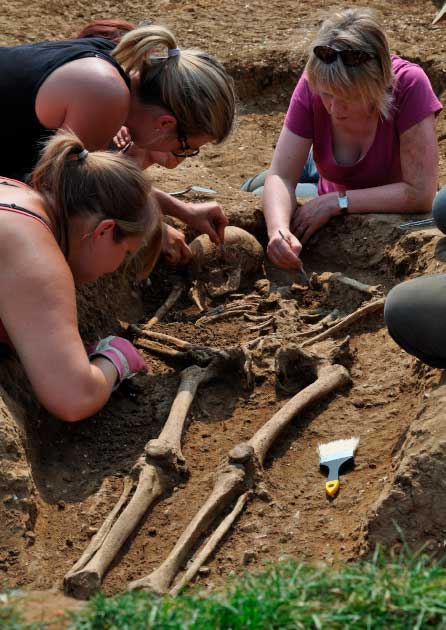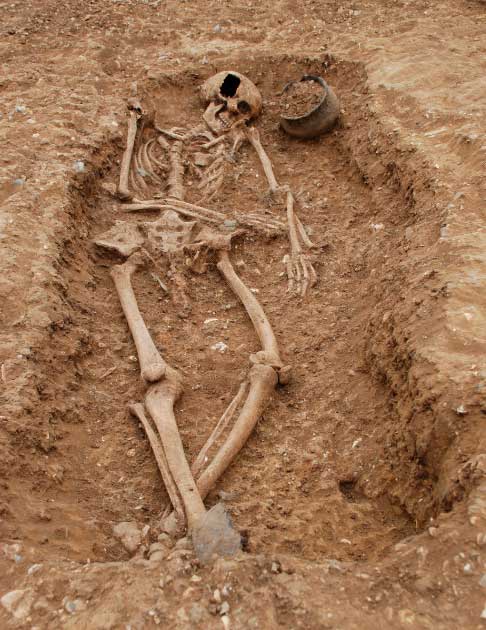The history of the British Isles is marked by several phases of migration and multiple periods of monumental change, including invasions by the Romans, Vikings and the Normans, and mass migration by the Celtics and the Anglo-Saxons. A new genome-based study shows that almost 75% of the population of eastern and southern England came from Anglo-Saxon migrations originating from continental regions bordering the North Sea, especially from the Netherlands, Germany, and Denmark.
Professor Ian Barnes, a Merit Researcher at the Natural History Museum, who co-authored the Anglo-Saxon migration study, said, “It’s great that we’ve been able to contribute to this extensive study of the early English, as there’s almost no ancient DNA (aDNA) work on the Anglo-Saxon period. The results are fascinating and flag up how significant the change in the population was at this time.”
‘Outsider’ Anglo-Saxon Migrations Defined Medieval England
The open-access study, published in Nature, shows that the new Anglo-Saxon migration arrivals from continental Europe interbred with the existing English peoples. This integration was not uniform or deliberate in any way across eastern and southern England, and thus varied from region to region, and community to community.
The study used genetic data from over 4,000 ancient people and 10,000 present-day Europeans to build a database that helped identify subtle genetic differences between the closely related groups that inhabited the ancient North Sea region .
Most of the continental European arrivals migrated in the four hundred years between 400 and 800 AD, including the Angles, one of the main Germanic peoples who settled in Great Britain in the post-Roman period. The word England is derived from the Angles. These findings indicate that the formation of early medieval British society was highly influenced by “outsiders” or immigrants from the continent.
“With 278 ancient genomes from England and hundreds more from Europe, we now gained really fascinating insights into population-scale and individual histories during post-Roman times ,” said Joscha Gretzinger, a lead author of the study. “Not only do we now have an idea of the scale of migration, but also how it played out in communities and families.”

Archaeologists excavating grave #112 at the Oakington, Cambridgeshire site, which was used in the Anglo-Saxon migration study. This particular grave contained an adult male buried with a knife, whose ancestry was 99.99% Continental Northern European. ( Nature)
Anglo-Saxon England or early Medieval England (5th-11th century AD), is the period of history between the decline of Roman Britain, and the Norman conquest of 1066. It was a monumental time in English history.
The identity of England created by the Anglo-Saxon migrations of 400-800 AD survived much beyond the Norman conquest. A study of ancient genomes concluded that a third of the English population today is Anglo-Saxon (this concentration is far greater in certain regions, particularly in eastern or southern England). For comparison consider that the British population’s Viking ancestry is only about 6%.
Rome’s Decline and the Anglo-Saxon Migrations
In the 8th century, an English monk named Bede wrote a history of the island of Britain. According to a study published in Science, Bede accurately predicted that Rome’s decline in 400 AD led to invasions from the Angles, Saxons, and Jute tribes from north-western Germany and Denmark.
The Bede wrote that these invasions “came over into the island, and they began to increase so much, that they became terrible to the natives.” When 20th-century historians and archaeologists discovered Bede’s writings on this topic, they felt that he exaggerated the scale of these invasive migrations into England from continental Europe.
The accepted notion was that it was probably a small population of warrior elites who used violence and brutality to impose their culture on the English as invaders not as a wave of migrants. The British Isles and Ireland have long histories of significant changes in language and settlement patterns indicating that migrant outsiders brought new ideas. A study published in June showed that both men and women immigrated in large numbers across the English Channel from the continent.
Throughout history the coastal areas of big islands facing a mainland have been completely overtaken by migrants from the larger landmass. Therefore, Bede’s early writings on this subject stand to reason. And they also provide evidence for the argument that much cultural change is driven by migrations more than say technological advances or new beliefs in societies without outsider migrants.
England Started To Look Like Europe After The Migrations!
Material history also backs up Bede’s claims. Modern archaeologists found that after 450 AD, Roman style culture, architecture, and pottery starts to fade away in the regions they conquered, including much of the British Isles. Instead, tools, swords, jewelry, and houses started to take on the features and characteristics found in these things across the English Channel. England was being “Europeanized.”
Within 200 years of the Anglo-Saxon migration the distinction between Roman Britain and Anglo-Saxon Britain was quite obvious. There had been a change in power and control from the Romans to the Anglo-Saxons. Burial evidence also provides evidence for this shift. Samples taken from 20 cemeteries across the English east coast showed a trend towards continental influences in burial customs, for women for example, and cemetery designs.
“Some Anglo-Saxon sites look almost 100% continental European. The only explanation is a large amount of people coming in from the North Sea zone,” added Joscha Gretzinger, a geneticist with the Max Planck Institute for Evolutionary Anthropology.
Dramatic changes in culture and language were also ushered in by the Anglo-Saxon migration. Celtic languages and Latin were slowly replaced by Old English, a Germanic language that shares vocabulary with German and Dutch. And the evidence shows that a significant number of Germanic speakers in lowland Britain were created by these migrations.

An early Anglo-Saxon grave with pottery vessel, brooches, and a Roman spoon. This grave (#66) from the Oakington, Cambridgeshire site was a woman of mixed ancestry. ( Nature)
In fact, intermarriage and integration would last for centuries, with certain sites showing three to four generations of Northern European DNA being buried together. Perhaps, entire families, communities, or even villages, just upped and migrated.
Duncan Sayer, archaeologist from the University of Central Lancashire and a lead author of the study concludes, “We see considerable variation in how this migration affected communities. In some places, we see clear signs of active integration between locals and immigrants, as in the case of Buckland near Dover, or Oakington in Cambridgeshire. Yet in other cases, like Apple Down in West Sussex, we see that people with immigrant and local ancestry were buried separately in the cemetery. Perhaps this is evidence of some degree of social separation at this site.”
Studies like this challenge the notion of British isolation and the occasional conquest by outsiders. Perhaps, going forward, it would be better to view migration and mobility as constants of the human condition.
Top image: Archaeologists excavating a complicated triple burial at England’s Oakington Cambridgeshire site, which was used in the recent Nature study to determine the true impact of Anglo-Saxon migration on medieval eastern and southern England. Source: Nature
By Sahir Pandey
 RSS Feed
RSS Feed















 September 23rd, 2022
September 23rd, 2022  Awake Goy
Awake Goy  Posted in
Posted in  Tags:
Tags: 













